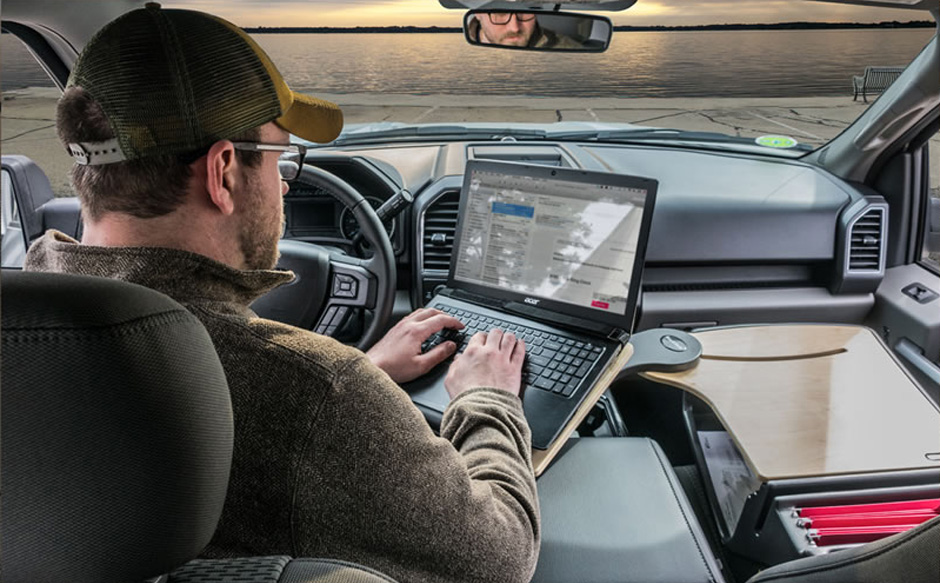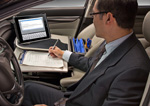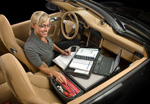 Loading... Please wait...
Loading... Please wait...
Ergonomics on the Go: Vehicle and Car Desks for Your Mobile Office

In-car offices are trending with working professionals who make customer and project visits. Converting car and truck cab space into workstations is easy.
As modern societies inch toward driverless vehicles, another part of the car experience is a step ahead of that. It’s how our cars have become mobile offices, which is evident in several ways with products, services, and software that accommodate the mobile worker.
But first it helps to consider how the car and car seats were not designed to be offices. The person with phone calls to make, notes to take, data to input, and pages to print has a lot to juggle in the seats of vehicles. To answer these needs, several manufacturers designed and produced various types of car desks and accessories that enable car interiors to adapt to mobile work. The result is an efficient and professional execution of mobile work functions in ergonomically-improved conditions.
Remarkably, there are numerous ways to accommodate the many types of mobile workers – realtors, appraisers, insurance adjustors, land surveyors, appliance repairmen, construction supervisors, healthcare professionals, and other personal and professional service providers – who look for ways to be as productive from the road as they are in an office. The features of vehicle workstations are simple yet essential:
Non-skid desktop areas. Not all parking spots are perfectly level, and no one likes hunting around a car floor to find a pen or glasses or a cell phone. This is why a car or truck desk should have a non-skid material. This “grip master” desk uses a rubberized material in addition to storage compartments to keep phones, files, pens, and other tools within easy reach.
Hardcopy file managers. We aren’t a paperless society just yet – many mobile workers need to produce or reference hardcopy documents in the course of their work. This "file master" desk has two file organizer buckets and is also secured in the passenger-side seat with a safety belt (as are many other models).
Tablet holder. Tablets were largely designed for mobile work, as a visit to any construction site or special event management company will illustrate. This is what led to the development of an articulated, spring-loaded arm feature of vehicle desks: they enable the user to work the tablet with a desk below for documents, files, phones, and note taking. Most car desks come with storage capabilities in one form or another.
Ergonomic flexibility. Again, a car seat was not designed to be a work station. And to be clear, it’s inadvisable for anyone to spend many hours of a day working from a driver’s seat (while parked, of course) while his or her torso is torqued to the right to face a mobile desk. But some car desk models are designed to at least alleviate some of the asymmetry with a pullout tray.
Made for trucks with pullout extensions. Larger trucks (such as the Ford F-150 or F-450) are the preferred mode of transportation for all kinds of mobile workers. With additional features such as an adjustable ball-mount arm that extends the work surface and enables a keyboard tilt, with a soft rubber ergonomic wrist rest, the “reach desk” model allows big work assignments to be completed with elegance and efficiency. This model also can be accessorized with a built-in power inverter, a printer stand, iPad/table mount-holder mechanism, and file tote. A wheel desk hooks into the steering wheel for note taking – while parked, of course.
Accessories tote and storage. A laptop desk for vehicle work can’t exist in a vacuum, nor do its contents stay in the car all the time. Files, laptops, collateral material and other tools of the trade should have a neat way to be transported to a bricks-and-mortar office with a tote organizer.
Vehicle workstation technical support innovations
It’s a funny thing in our digital age how face-to-face meetings and on-site connections to the work itself are driving office-in-car innovations. Smart businesses and business people aren’t hiding behind screens.
All kinds of product innovators are coming up with ways to accommodate that. Those products include the collaboration between automaker Mercedes Benz and Microsoft that created “In Car Office,” a car feature that syncs Microsoft Exchange calendars, contact information, and to-do lists. Married to geo information, it prompts the driver to make calls and stops in time-efficient ways.
Other signs that working from one’s car is becoming commonplace: the Lenovo Thinkpad X250, a road-friendly laptop; dashboard phone mounts and sound system aux cables; OnStar 4G LTE providing better Internet signal reception than with a phone; power inverters that provide clean charges for all the electronics; and mobile ink-jet printers (e.g., Canon Pixma ip110) that provide instant hardcopy contracts, receipts, and handouts that facilitate in-person meetings in the most timely fashion.
So while driverless vehicles are still in the experimentation phase most mobile workers still have to do the driving themselves. But once they reach their destination, they can use other automation to get the job done with speed, efficiency, and impressive professionalism.
If you have any questions about office ergonomics, ergonomic office products and accessories, feel free to give us a call at 888-404-2136 or use our contact page.






